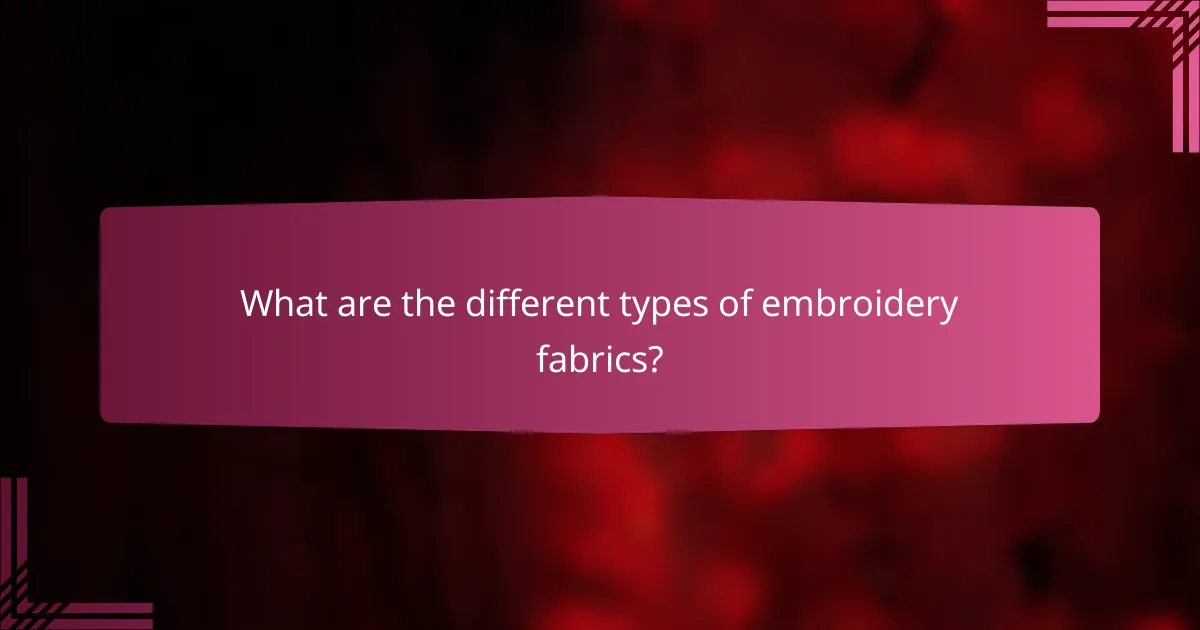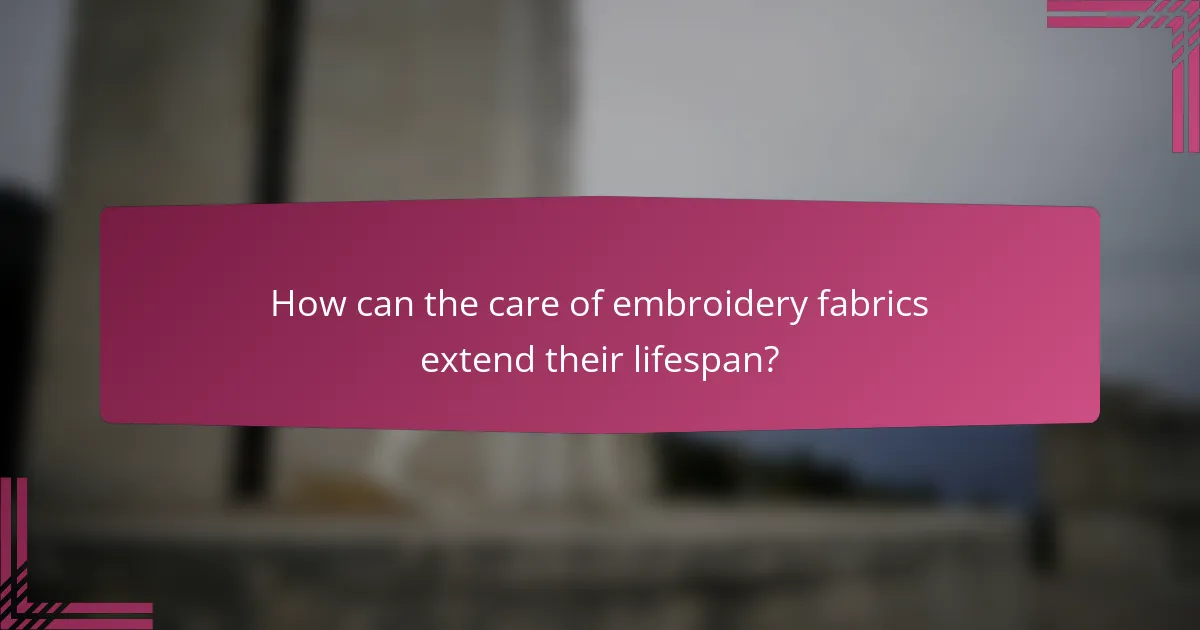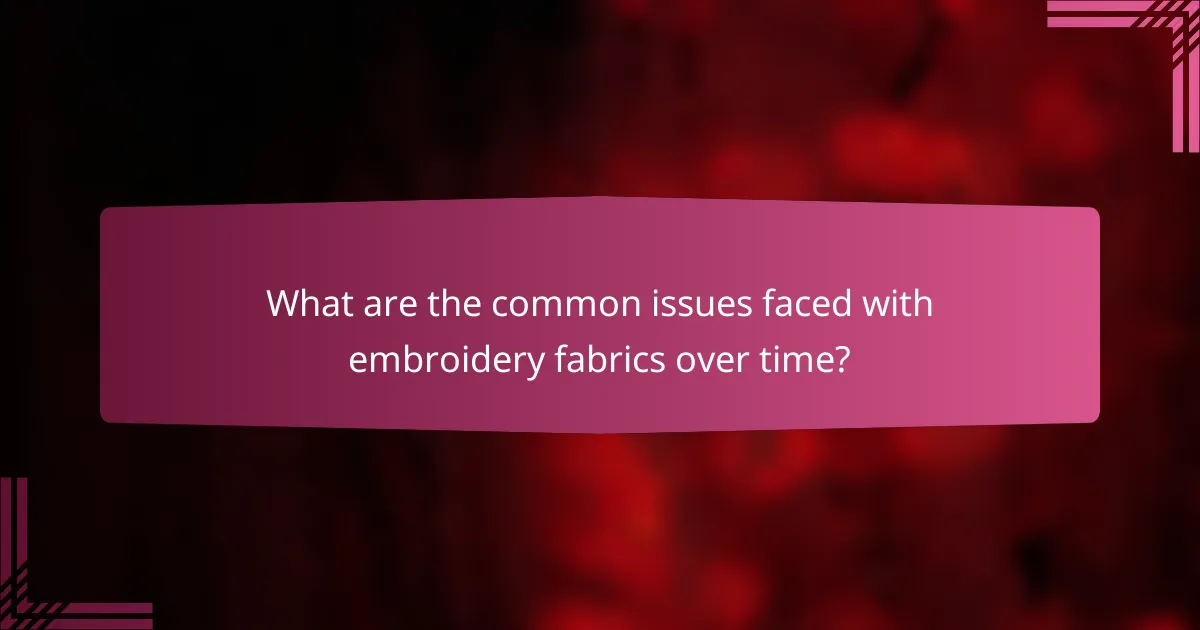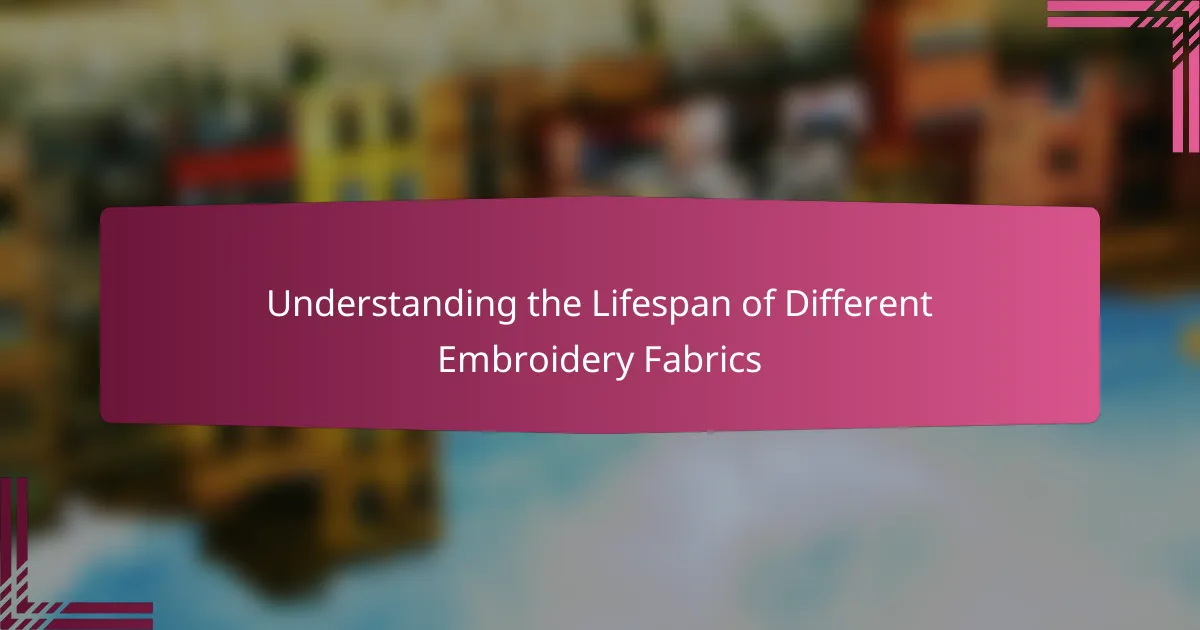
What are the different types of embroidery fabrics?
The different types of embroidery fabrics include cotton, linen, silk, polyester, and canvas. Cotton is widely used for its affordability and versatility. Linen offers a natural texture and durability. Silk provides a luxurious finish but can be more delicate. Polyester is synthetic, known for its strength and resistance to wrinkles. Canvas is heavy-duty, suitable for larger embroidery projects. Each fabric type has unique characteristics that affect the embroidery technique and final appearance.
How do natural fibers differ from synthetic fibers in embroidery?
Natural fibers differ from synthetic fibers in embroidery primarily in their composition and properties. Natural fibers, such as cotton and linen, are derived from plants or animals. They tend to be more breathable and absorb moisture better than synthetic fibers. Synthetic fibers, like polyester and nylon, are man-made and often more durable and resistant to fading.
Natural fibers can shrink or stretch when exposed to moisture. This can affect the final appearance of the embroidery. Synthetic fibers maintain their shape and color more reliably over time. Additionally, natural fibers may require more care during washing to prevent damage, while synthetic fibers are typically easier to care for.
The choice between natural and synthetic fibers impacts the longevity and quality of embroidery projects. Natural fibers provide a softer feel, while synthetic fibers offer greater durability.
What are the unique properties of cotton as an embroidery fabric?
Cotton has unique properties that make it an excellent embroidery fabric. It is highly absorbent, allowing for vibrant dye uptake. This quality ensures that colors remain rich and true over time. Cotton is also soft and breathable, providing comfort in wear. Its natural fibers allow for easy manipulation during embroidery. Additionally, cotton has good strength, which contributes to durability. It resists wrinkles and creases, maintaining a neat appearance. Cotton’s versatility allows it to be used in various embroidery techniques. These properties make cotton a preferred choice for both hobbyists and professionals in embroidery.
What advantages does polyester offer in embroidery projects?
Polyester offers several advantages in embroidery projects. It is highly durable, which enhances the longevity of embroidered designs. Polyester resists fading and shrinking, maintaining vibrant colors over time. The fabric has a smooth surface, allowing for precise stitching. This smoothness reduces thread breakage during the embroidery process. Polyester is also water-resistant, making it suitable for various applications, including outdoor items. Additionally, it is easy to care for and can withstand multiple washes without losing quality. These characteristics make polyester a preferred choice for many embroidery projects.
What factors influence the lifespan of embroidery fabrics?
The lifespan of embroidery fabrics is influenced by several key factors. Material composition plays a significant role; natural fibers like cotton tend to wear out faster than synthetic fibers like polyester. The quality of the embroidery thread also affects durability; high-quality threads resist fraying and fading better than low-quality options. Environmental conditions, such as exposure to sunlight and humidity, can lead to deterioration over time. Proper care and maintenance, including washing methods and storage conditions, are crucial for preserving fabric integrity. Additionally, the type of embroidery technique used can impact longevity; dense stitching may weaken the fabric more than lighter techniques. Research indicates that fabrics exposed to harsh chemicals or frequent washing experience reduced lifespans.
How does the weight of the fabric affect its durability?
The weight of the fabric significantly affects its durability. Heavier fabrics typically have a tighter weave and greater fiber density. This density provides enhanced resistance to wear and tear. For example, canvas and denim are heavyweight fabrics known for their strength. These materials can withstand stress better than lighter options. Conversely, lightweight fabrics may fray or tear more easily. They often lack the structural integrity needed for long-term use. Research indicates that heavier fabrics can last longer under similar conditions. This durability makes them preferable for items subjected to frequent use.
What role does thread type play in the longevity of embroidery?
Thread type significantly influences the longevity of embroidery. Different thread materials, such as cotton, polyester, and rayon, have varying durability levels. Polyester threads are known for their strength and resistance to fading. Cotton threads, while softer, may wear out more quickly under stress. The choice of thread impacts how well the embroidery withstands washing, sunlight, and abrasion. For example, polyester threads can endure multiple washes without losing color or integrity. Additionally, the thickness of the thread can affect the overall durability of the design. Thicker threads generally provide more robust stitching, enhancing the lifespan of the embroidery. Therefore, selecting the appropriate thread type is crucial for achieving long-lasting embroidery results.

How can the care of embroidery fabrics extend their lifespan?
Proper care of embroidery fabrics can significantly extend their lifespan. Washing embroidery fabrics gently in cold water prevents color fading and fabric damage. Using mild detergents protects the delicate threads and embellishments. Air drying instead of machine drying reduces the risk of shrinkage and wear. Storing embroidery fabrics in a cool, dry place prevents mold and mildew. Avoiding direct sunlight preserves the colors and integrity of the fabric. Regularly inspecting for loose threads and repairing them promptly maintains the fabric’s overall condition. These practices collectively ensure that embroidery fabrics remain vibrant and intact for a longer period.
What washing techniques are best for preserving embroidery fabrics?
Hand washing is the best technique for preserving embroidery fabrics. This method minimizes agitation and reduces the risk of damage. Use cool or lukewarm water to protect delicate threads. Mild detergent specifically designed for delicate fabrics is recommended. Avoid bleach and harsh chemicals, as they can fade colors and weaken fibers. Gently swish the fabric in the water without rubbing or wringing it. Rinse thoroughly with cool water to remove all detergent residues. Lay the fabric flat to dry, avoiding direct sunlight to prevent color fading. These methods help maintain the integrity and appearance of embroidered designs.
How does temperature affect the care of different fabrics?
Temperature significantly affects the care of different fabrics. High temperatures can cause shrinkage in natural fibers like cotton and wool. Synthetic fabrics may melt or become misshapen when exposed to excessive heat. Cold temperatures can lead to stiffness in fabrics such as denim. Washing fabrics at the wrong temperature can result in color fading or bleeding. For example, silk should be washed in cold water to maintain its luster. Linen, on the other hand, can withstand higher temperatures during ironing. Proper temperature management prolongs the lifespan of embroidery fabrics. Understanding these temperature effects ensures better care and maintenance of various textiles.
What drying methods should be avoided to maintain fabric integrity?
Avoid using high heat drying methods to maintain fabric integrity. High heat can cause shrinkage and damage delicate fibers. Air drying is safer for most fabrics. Tumble drying on low heat is also an option, but it may still risk fabric integrity over time. Avoid wringing out fabrics to remove excess water, as this can distort their shape. Additionally, direct sunlight exposure during drying can fade colors and weaken fibers. Using harsh chemicals in drying processes can further compromise fabric strength. Always refer to care labels for specific drying instructions.
What storage practices help maintain the quality of embroidery fabrics?
To maintain the quality of embroidery fabrics, proper storage practices are essential. Store fabrics in a cool, dry environment to prevent moisture damage. Use acid-free tissue paper to separate layers and avoid creasing. Avoid hanging fabrics, as this can cause stretching. Instead, fold them neatly and place them in a breathable container. Keep fabrics away from direct sunlight to prevent fading. Regularly check stored fabrics for signs of pests or mold. Following these practices can significantly extend the lifespan of embroidery fabrics.
How can exposure to light impact the lifespan of embroidery fabrics?
Exposure to light can significantly reduce the lifespan of embroidery fabrics. Prolonged exposure to ultraviolet (UV) light causes fading and degradation of colors. This process weakens the fibers, leading to increased wear and tear. Natural and artificial light can both contribute to this effect. Fabrics made from synthetic fibers tend to be more resistant to light damage than natural fibers. For instance, cotton and silk are particularly susceptible to UV rays. Research indicates that UV exposure can decrease fabric strength by up to 30% over time. Therefore, protecting embroidery fabrics from direct light is essential for maintaining their quality and longevity.

What are the common issues faced with embroidery fabrics over time?
Embroidery fabrics commonly face issues such as fading, fraying, and discoloration over time. Fading occurs due to prolonged exposure to sunlight and washing. Fraying happens when the fabric edges unravel, often from wear and tear. Discoloration can result from improper washing techniques or exposure to harsh chemicals. Additionally, embroidery threads may weaken, leading to potential unraveling of designs. Shrinkage is another concern, particularly with natural fibers. These issues can affect the overall appearance and durability of the fabric. Regular maintenance can help mitigate some of these problems.
How do environmental factors contribute to fabric deterioration?
Environmental factors significantly contribute to fabric deterioration. Exposure to sunlight can cause fading and weakening of fibers. High humidity levels promote mold and mildew growth, damaging the fabric structure. Low humidity can lead to brittleness and cracking in certain materials. Temperature fluctuations can cause fibers to expand and contract, leading to stress and eventual breakage. Pollution and dust accumulation can also degrade fabric quality over time. Chemical exposure from cleaning agents may weaken fibers and alter their appearance. Overall, these environmental factors collectively reduce the lifespan of fabrics, particularly in embroidery.
What signs indicate that an embroidery fabric is wearing out?
Signs that indicate an embroidery fabric is wearing out include fraying edges and thinning areas. Fraying occurs when the threads unravel, leading to a rough texture. Thinning areas suggest that the fabric is losing its density. Additionally, discoloration can signal fading due to prolonged exposure to sunlight or washing. Another sign is the presence of holes or tears, which compromise the fabric’s integrity. Lastly, a loss of elasticity can occur, making the fabric feel less resilient. These signs collectively indicate that the embroidery fabric may need replacement.
How can one prevent common issues like fading or fraying?
To prevent common issues like fading or fraying, use appropriate care techniques. Regularly wash fabrics in cold water to maintain color integrity. Avoid direct sunlight exposure, as UV rays can cause fading. Store items in a cool, dry place to minimize moisture damage. Use fabric protectors designed to enhance durability. Opt for high-quality threads and fabrics that resist fraying. Following these practices can significantly extend the lifespan of embroidered items.
What best practices can be followed for long-lasting embroidery projects?
Use high-quality materials for long-lasting embroidery projects. Quality threads and fabrics enhance durability. Cotton and polyester blends are often recommended for their strength. Pre-wash fabrics to prevent shrinkage and color bleeding. Use stabilizers to support the fabric during stitching. Proper hooping techniques reduce puckering and distortion. Follow care instructions for washing and drying to maintain the design. Store finished projects in a cool, dry place to prevent damage. These practices ensure the longevity of embroidery work.
The main entity of the article is embroidery fabrics, with a focus on their lifespan and the factors influencing it. The article provides an overview of various types of embroidery fabrics, including cotton, linen, silk, polyester, and canvas, detailing their unique properties and care requirements. It explores the differences between natural and synthetic fibers, the impact of fabric weight, thread type, and environmental factors on durability. Additionally, it outlines best practices for maintaining the quality of embroidery fabrics and preventing common issues such as fading and fraying, ensuring long-lasting results in embroidery projects.
